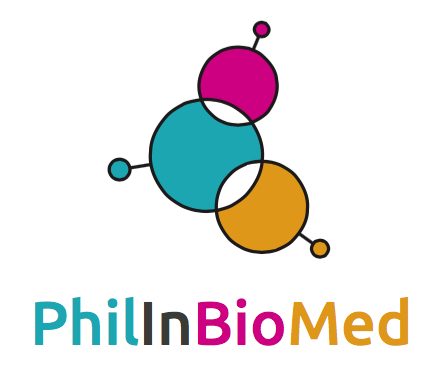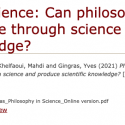Ralph Adolphs is a Professor of Psychology, Neuroscience, and Biology at the California Institute of Technology. Furthermore he is the Director of the Emotion and Social Cognition Lab, which investigates the neural underpinnings of human social behavior. He is also a member of the PhilInBioMed Scientific Committee.
Post Type Archives: Custom Types
Brian McGill
Brian McGill is a Professor of Ecological Modelling at the University of Maine. His research focuses on the intersection of biodiversity, global change, and big data. He has a long standing interest in thinking, talking, and writing about how scientists do their work.
The origin of RNA interference: Adaptive or neutral evolution?
Abstract
The origin of RNA interference (RNAi) is usually explained by a defense-based hypothesis, in which RNAi evolved as a defense against transposable elements (TEs) and RNA viruses and was already present in the last eukaryotic common ancestor (LECA). However, since RNA antisense regulation and double-stranded RNAs (dsRNAs) are ancient and widespread phenomena, the origin of defensive RNAi should have occurred in parallel with its regulative functions to avoid imbalances in gene regulation. Thus, we propose a neutral evolutionary hypothesis for the origin of RNAi in which qualitative system drift from a prokaryotic antisense RNA (asRNA) gene regulation mechanism leads to the formation of RNAi through constructive neutral evolution (CNE). We argue that RNAi was already present in the ancestor of LECA before the need for a new defense system arose and that its presence helped to shape eukaryotic genomic architecture and stability.
Read more.
The Evolution of the Hallmarks of Aging
Abstract
The evolutionary theory of aging has set the foundations for a comprehensive understanding of aging. The biology of aging has listed and described the “hallmarks of aging,” i.e., cellular and molecular mechanisms involved in human aging. The present paper is the first to infer the order of appearance of the hallmarks of bilaterian and thereby human aging throughout evolution from their presence in progressively narrower clades. Its first result is that all organisms, even non-senescent, have to deal with at least one mechanism of aging – the progressive accumulation of misfolded or unstable proteins. Due to their cumulation, these mechanisms are called “layers of aging.” A difference should be made between the first four layers of unicellular aging, present in some unicellular organisms and in all multicellular opisthokonts, that stem and strike “from the inside” of individual cells and span from increasingly abnormal protein folding to deregulated nutrient sensing, and the last four layers of metacellular aging, progressively appearing in metazoans, that strike the cells of a multicellular organism “from the outside,” i.e., because of other cells, and span from transcriptional alterations to the disruption of intercellular communication. The evolution of metazoans and eumetazoans probably solved the problem of aging along with the problem of unicellular aging. However, metacellular aging originates in the mechanisms by which the effects of unicellular aging are kept under control – e.g., the exhaustion of stem cells that contribute to replace damaged somatic cells. In bilaterians, additional functions have taken a toll on generally useless potentially limited lifespan to increase the fitness of organisms at the price of a progressively less efficient containment of the damage of unicellular aging. In the end, this picture suggests that geroscience should be more efficient in targeting conditions of metacellular aging rather than unicellular aging itself.
Read more.
Between mechanical clocks and emergent flocks: complexities in biology
Abstract
Even though complexity is a concept that is ubiquitously used by biologists and philosophers of biology, it is rarely made precise. I argue that a clarification of the concept is neither trivial nor unachievable, and I propose a unifying framework based on the technical notion of “effective complexity” that allows me to do justice to conflicting intuitions about biological complexity, while taking into account several distinctions in the usage of the concept that are often overlooked. In particular, I propose a distinction between two kinds of complexity, “mechanical” and “emergent”, which can be understood as different ways of relating the effective complexity of mechanisms and of behaviors in biological explanations. I illustrate the adequacy of this framework by discussing different attempts to understand intracellular organization in terms of pathways and networks. My framework provides a different way of thinking about recent philosophical debates, for example, on the difference between mechanistic and topological explanations and about the concept of emergence. Moreover, it can contribute to a proper assessment of metascientific arguments that invoke biological complexity.
Read more.
Philosophy in science by Pradeu T, Lemoine M, Khelfaoui M and Gingras Y
Abstract
Most philosophers of science do philosophy ‘on’ science. By contrast, others do philosophy ‘in’ science (‘PinS’), i.e., they use philosophical tools to address scientific problems and to provide scientifically useful proposals. Here, we consider the evidence in favour of a trend of this nature. We proceed in two stages. First, we identify relevant authors and articles empirically with bibliometric tools, given that PinS would be likely to infiltrate science and thus to be published in scientific journals (‘intervention’), cited in scientific journals (‘visibility’) and sometimes recognized as a scientific result by scientists (‘contribution’). We show that many central figures in philosophy of science have been involved in PinS, and that some philosophers have even ‘specialized’ in this practice. Second, we propose a conceptual definition of PinS as a process involving three conditions (raising a scientific problem, using philosophical tools to address it, and making a scientific proposal), and we ask whether the articles identified at the first stage fulfil all these conditions. We show that PinS is a distinctive, quantitatively substantial trend within philosophy of science, demonstrating the existence of a methodological continuity from science to philosophy of science.
Read more.
Reframing Nutritional Microbiota Studies To Reflect an Inherent Metabolic Flexibility of the Human Gut: a Narrative Review Focusing on High-Fat Diets by Sholl J, Mailing LJ, Wood TR.
Abstract
There is a broad consensus in nutritional-microbiota research that high-fat (HF) diets are harmful to human health, at least in part through their modulation of the gut microbiota. However, various studies also support the inherent flexibility of the human gut and our microbiota’s ability to adapt to a variety of food sources, suggesting a more nuanced picture. In this article, we first discuss some problems facing basic translational research and provide a different framework for thinking about diet and gut health in terms of metabolic flexibility. We then offer evidence that well-formulated HF diets, such as ketogenic diets, may provide healthful alternative fuel sources for the human gut. We place this in the context of cancer research, where this concern over HF diets is also expressed, and consider various potential objections concerning the effects of lipopolysaccharides, trimethylamine-N-oxide, and secondary bile acids on human gut health. We end by providing some general suggestions for how to improve research and clinical practice with respect to the gut microbiota when considering the framework of metabolic flexibility.
Read more.
Can aging research generate a theory of health? by Jonathan Sholl
Abstract
While aging research and policy aim to promote ‘health’ at all ages, there remains no convincing explanation of what this ‘health’ is. In this paper, I investigate whether we can find, implicit within the sciences of aging, a way to know what health is and how to measure it, i.e. a theory of health. To answer this, I start from scientific descriptions of aging and its modulators and then try to develop some generalizations about ‘health’ implicit within this research. After discussing some of the core aspects of aging and the ways in which certain models describe spatial and temporal features specific to both aging and healthy phenotypes, I then extract, explicate, and evaluate one potential construct of health in these models. This suggests a theory of health based on the landscape of optimized phenotypic trajectories. I conclude by considering why it matters for more candidate theories to be proposed and evaluated by philosophers and scientists alike.
Read more.
Taking a Naturalistic Turn in the Health and Disease Debate by Jonathan Sholl & Simon Okholm
Abstract
We situate the well-trodden debate about defining health and disease within the project of a metaphysics of science and its aim to work with and contribute to science. We make use of Guay and Pradeu’s ‘metaphysical box’ to reframe this debate, showing what is at stake in recent attempts to move beyond it, revealing unforeseen points of agreement and disagreement among new and old positions, and producing new questions that may lead to progress. We then discuss the implications of the two-way benefits between medicine and philosophy when the latter is driven and constrained by medical science.
Read more Sholl & Okholm 2021 – Taking a naturalistic turn in the health and disease debate.
Out of our skull, in our skin: the Microbiota-Gut-Brain axis and the Extended Cognition Thesis by F. Boem, G. Ferreti, S. Zipoli Caiani
Abstract
According to a shared functionalist view in philosophy of mind, a cognitive system, and cognitive function thereof, is based on the components of the organism it is realized by which, indeed, play a causal role in regulating our cognitive processes. This led philosophers to suggest also that, thus, cognition could be seen as an extended process, whose vehicle can extend not only outside the brain but also beyond bodily boundaries, on different kinds of devices. This is what we call the ‘Externally Extended Cognition Thesis.’ This notion has generated a lively debate. Here, we offer a novel notion of extended cognition, according to which cognition can be seen as being realized (and expanded) outside the brain, but still inside the body. This is what we call the ‘Internally Extended Cognition Thesis’. Not only our thesis but also our approach while defending it is innovative. The argument we offer is supported by recent empirical findings in the life sciences and biomedicine, which suggest that the gut microbiota’s activity has a functional role in regulating our cognitive processes and behaviors. In doing so, we embrace the holobiont-perspective, according to which it is possible to claim that what we call biological individuals are not autonomous entities with clear boundaries, but should rather be seen as networks of multiple interactions among species. Thus, by analyzing different sets of evidence in light of the holobiont-perspective, we argue that the gut microbiota could be seen as a component of our organism. On the basis of the philosophical interpretation of this evidence, however, we also suggest that there are no impediments standing the way of considering the gut microbiota also as a functional extension of our cognitive system. If so, this amounts to extending cognition out of ‘our skull’, though still confining it within ‘our body’: to ‘our gut’. This is an instance of the ‘Internally Extended Cognition Thesis,’ whose benefits for an original (biologically informed) theory of extended cognition are discussed.
Read more here.








